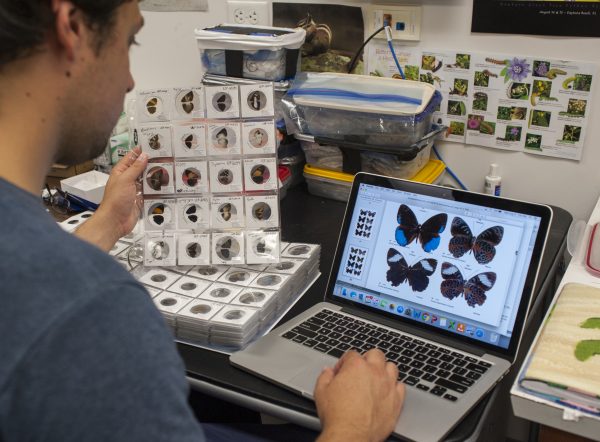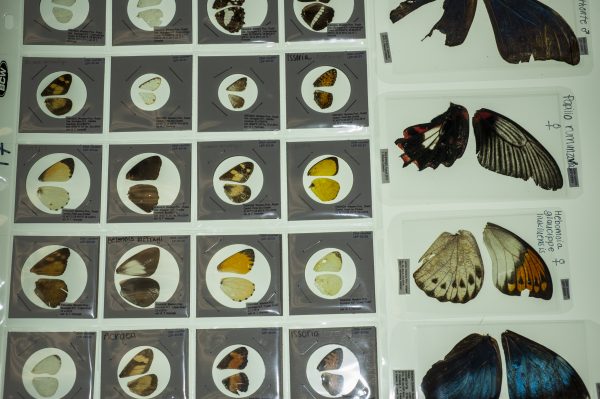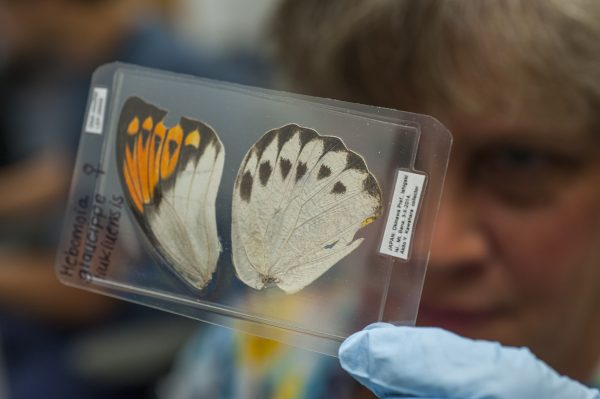As a vegan and animal lover, lab technician Samantha Epstein had always envisioned a future working with wildlife.
“I definitely love working with live specimens, studying their behavior,” she said. “I never really thought I’d be working with dead stuff.”

Florida Museum photo by Jeff Gage
Lab techs and volunteers are an integral part of research at the Florida Museum of Natural History. In the Kawahara Lab at the Museum’s McGuire Center for Lepidoptera & Biodiversity, Epstein and other research assistants help Lepidoptera assistant curator Akito Kawahara with a lot of the day-to-day work required for tagging, cataloging and studying butterfly and moth specimens.
The lab has about 20,000 molecular specimens cataloged, which have been collected over the past five years, he said.
“We are interested in all kinds of questions,” Kawahara said. “From basic stuff like the evolution and relationships of many of these moth groups, to things like the genes that are associated with particular wing patterns or shapes and differences in populations.”
Lab techs were integral in Kawahara’s study on the evolution of luna moth tails, which help deflect bat sonar.
“Geena Hill did a lot of the rearing for the project because we had to grow lots of these moths to test them with bats,” Kawahara said.
Hill also completed much of the digital imaging and digitization for the project, including photographing moths to quantify the wing shape.
“There are not a lot of photos of moths in collections, and McGuire has one of the largest collections of Lepidoptera in the world,” Hill said. “So digitizing moths like those in the luna moth study and others for later projects will help scientists and the public see their characteristics more clearly.”

Florida Museum photo by Jeff Gage
Volunteers and lab technicians are currently working on a large project that involves creating wing vouchers: butterfly and moth wings kept in small slides and organized in binders. About 70 of these binders line a 15-foot wall in the lab.
Epstein uses them to easily look at the wing patterns of moths and butterflies. With dozens of these small squares on a page, they look somewhat like a stamp or coin collection at first glance.
But these squares contain details about the sizes, shapes and colors of Lepidoptera—important information when comparing different species.
Epstein, who spends much of her free time creating artwork, including pet portraits and coloring books she donates to local animal shelters, used some of her creative spark to solve a problem with cataloging larger specimens.
“The vouchers are small for bigger moths,” she said. “So species with bigger wings aren’t able to fit in them.”
She had the idea to laminate the bigger wings as one might a piece of paper.
“It kind of really is an art creating them,” she said. “This is both science and art.”
Epstein was co-author in a paper published in PeerJ in June 2016 that outlined the vouchering process, which Kawahara first used while he was in graduate school at the University of Maryland.
“It was a great idea,” he said. “I’ve heard people complain that you really don’t have the body, but I think you get 80 to 90 percent of what you want in those wing vouchers.”
Kawahara also pointed out that vouchers allow scientists to view the dorsal and ventral, or top and bottom, sides of the wings to see structures and patterns clearly.
Dried butterfly and moth wings are useful to view, but researchers also study the DNA of collected specimens, which are stored in cryogenic freezers. These liquid nitrogen-cooled freezers preserve tissue and cell samples by maintaining temperatures of minus 300 degrees Fahrenheit.
“The problem with preserving tissues like a lot of museums and institutions do, is then you don’t have morphological voucher reference to be able to identify them or look at them, so it’s kind of one extreme or the other,” Epstein said. “So we have a really unique way of preserving our stuff so it’s a little bit of both.”
Epstein began working in the lab about two years ago as a volunteer, and now one of her jobs is to recruit and train other interested volunteers.

Florida Museum photo by Jeff Gage
“We have a really nice range of volunteers that includes students, retirees and people who are just really into science or insects. Some volunteers have no prior experience at all and are just curious about what we do,” she said.
Carol Ward, who received a doctorate degree in medical microbiology and immunology from the University of Florida, retired from her position as a professor at a community college in Illinois before she began volunteering at the lab in January 2016.
“My only prior exposure (to Lepidoptera) was working a little bit with the Illinois Butterfly Monitoring Network,” she said.
Bringing her children to the Florida Museum when they were young was a memory that encouraged her to volunteer.
“At first I tried fossil digging,” Ward said. “My friend who enjoys doing that recommended it for me, but it was really backbreaking work, so I guess it’s not for everyone,” she said.
“After that, I came here to the lab, which is much better suited to my abilities,” she said.
Like the number of specimens, the number of volunteers working at the lab is constantly growing.
While showing a new potential volunteer around, Epstein said she remembered becoming interested in museum research when she first saw some of the entomology collection at the American Museum of Natural History in New York.
“I thought, ‘That’s a job? People can do this?’” she said. “And now it’s something that I do every day, and I get to help other people have that same experience here.”
Learn more about the McGuire Center for Lepidoptera & Biodiversity at the Florida Museum.